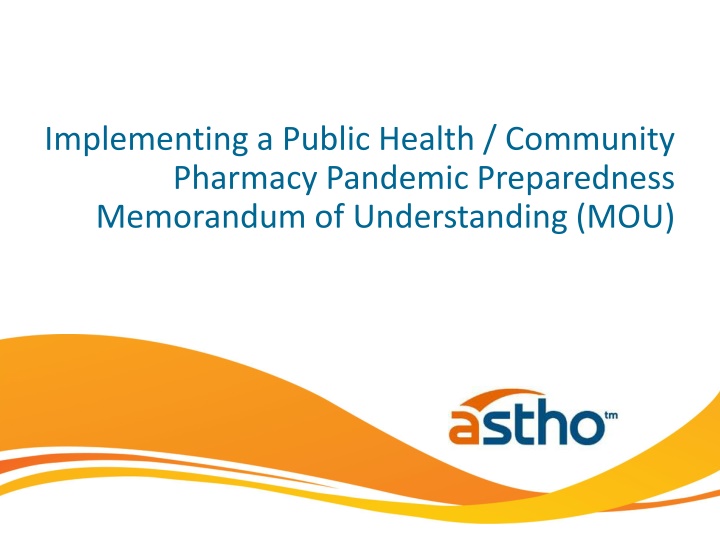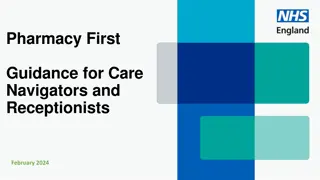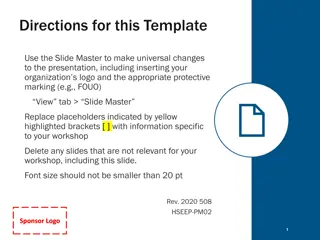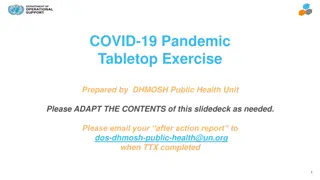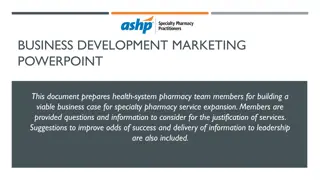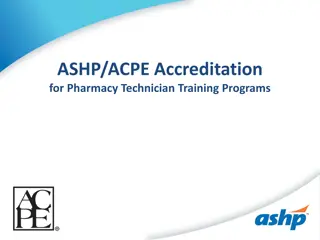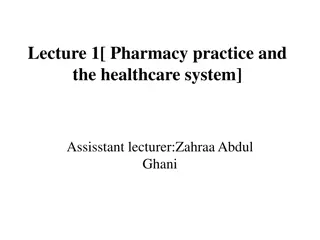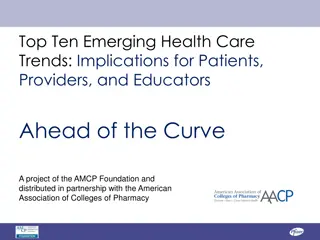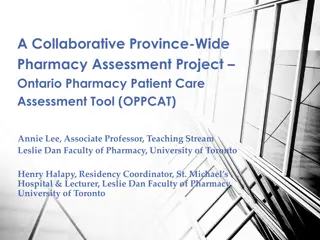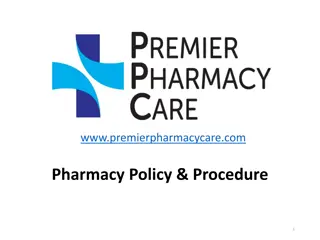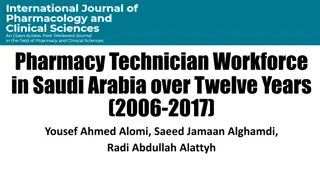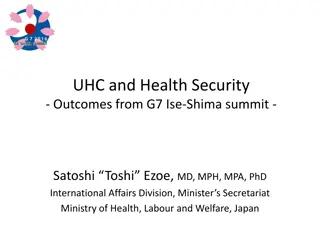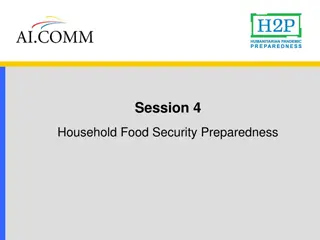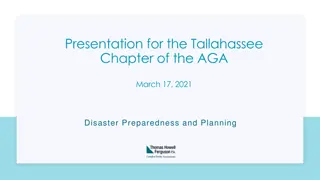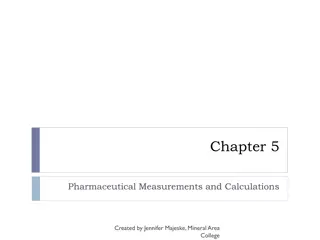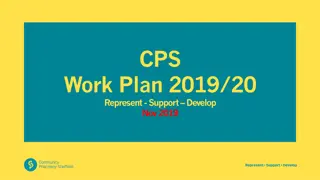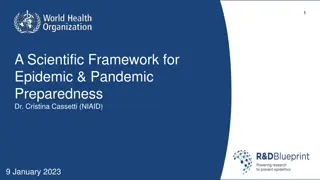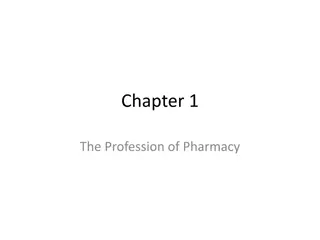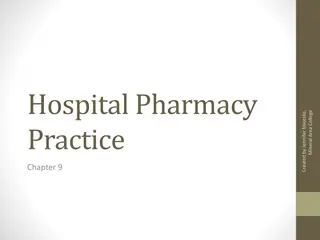Implementing a Public Health / Community Pharmacy Pandemic Preparedness Memorandum of Understanding (MOU)
Community pharmacies play a crucial role in pandemic preparedness by administering vaccines and protecting public health. This memorandum of understanding (MOU) outlines the collaboration between public health entities and community pharmacies, emphasizing the importance of timely vaccination and efficient distribution during a pandemic. By leveraging the accessibility and expertise of pharmacists, significant progress can be made in vaccination efforts to safeguard communities.
Download Presentation

Please find below an Image/Link to download the presentation.
The content on the website is provided AS IS for your information and personal use only. It may not be sold, licensed, or shared on other websites without obtaining consent from the author.If you encounter any issues during the download, it is possible that the publisher has removed the file from their server.
You are allowed to download the files provided on this website for personal or commercial use, subject to the condition that they are used lawfully. All files are the property of their respective owners.
The content on the website is provided AS IS for your information and personal use only. It may not be sold, licensed, or shared on other websites without obtaining consent from the author.
E N D
Presentation Transcript
Implementing a Public Health / Community Pharmacy Pandemic Preparedness Memorandum of Understanding (MOU)
Overview Overview MOU Background: How Did We Get Here? Mutual and Specific Benefits of an MOU For public health For community pharmacies MOU Components Enrollment and training Allocation Distribution Documentation Payment Communication Steps Toward Implementation
Community Pharmacy Role in Seasonal and Community Pharmacy Role in Seasonal and Pandemic Immunizations Pandemic Immunizations Pharmacists are already important routine immunizers across the United States Approximately 260,000 pharmacists provide vaccinations 20% of seasonal influenza vaccinations of adults are administered in a pharmacy or retail setting Pharmacists would become even more crucial during a pandemic Pharmacists were underutilized during H1N1 (2009) If vaccine were provided in a more timely way, the time to vaccinate the public could be reduced significantly Widespread vaccination at or after the peak of disease would have little impact
The Bottom Line: Public Health Needs Community The Bottom Line: Public Health Needs Community Pharmacies to Protect the Public During A Pandemic Pharmacies to Protect the Public During A Pandemic 250 Millions Total # Vaccines Administered 80% Adult Coverage 200 (Cumulative) 150 100 50 0 With Pharmacies Without Pharmacy 80% Coverage
Unique Influenza Pandemic Logistics/Planning Influenza Pandemic Seasonal Flu Federal government works with vaccine manufacturers to develop pandemic vaccine supply for entire U.S. Routinely handled as localized public health emergencies State public health programs receive weekly pro rata allocations and manage orders/distribution within the state Healthcare providers order pandemic vaccine from public health Seasonal flu vaccine is distributed directly to healthcare providers Higher levels of tracking may be required Recommendations for use may differ for pandemic vaccines (e.g., multiple doses, matching/mixing adjuvant) Administration is routine and familiar (repeated annually) Affects all groups and ages, so public health response must be broad and sustained Often focused on select age groups and subpopulations for a winter season
Planning Gaps Planning Gaps Few state or local public health agencies have formal agreements in place with pharmacies to improve pandemic response One-third of public health programs would incorporate pharmacies later in the vaccine response Too late! Even with sufficient vaccine supply, many public health programs report that less than 5% of state pandemic vaccine would be allocated to pharmacies
Addressing the Planning Gaps: An MOU Template Addressing the Planning Gaps: An MOU Template CDC and ASTHO Partnership (2013) to determine best practices for increasing coordination Template MOU (2015) Pilot project in three states to test implementing MOU (2015-2016) Arkansas Tennessee Georgia Stakeholder meeting at American Pharmacists Association (APhA) annual meeting (March 2016) APhA ASTHO CDC NASPA NACDS
Mutual Benefits: A Pandemic Preparedness MOU Mutual Benefits: A Pandemic Preparedness MOU Serves Public Health Serves Public Health and and Community Pharmacies Community Pharmacies Improved coordination before and during pandemic Stronger partnerships overall Faster, more efficient access to vaccine for the public
Specific Benefits For Community Pharmacies For Public Health Ensure early allocation of federal pandemic vaccine supply for community pharmacies Standardize operations and points of contact Develop a distribution approach in advance Educate public health about pharmacy planning and response Use public health infrastructure, as needed Reduce waste and improve efficiency Clarify expectations and plan for information sharing Strengthen partnerships for other public health emergencies as well as routine healthcare issues Leverage strengths of all partners Use existing pharmacy infrastructure to increase public vaccine access points Reach full vaccine coverage of the public sooner Ensure equity among all pandemic vaccinators Strengthen partnerships and model approaches for other dispensing and clinical services
MOU Components MOU Components Pharmacist vaccinator enrollment and training Pandemic vaccine allocation Pandemic vaccine distribution Pandemic vaccination documentation Includes use of immunization information systems (IIS) Pandemic vaccine payment issues Communication
Provider Enrollment and Training Provider Enrollment and Training Pharmacy may enroll/register all pharmacy sites as pandemic vaccination sites (vs. registering each site separately) Pharmacy is responsible for ensuring vaccinators have appropriate training, certification and following all guidance from state/CDC Pharmacy is expected to sign Pandemic Vaccine Provider Agreement Form, if and when available and required by CDC State responsible providing technical assistance, material, information, and resources, as available to assist the pharmacy
Allocation Allocation Existing vaccination capacity of pharmacy, geography, pandemic epidemiology, supply, and other factors should be considered in making allocation decisions and may vary over time Weekly pharmacy vaccine allocation from state should be considered in advance of response activation
Distribution Distribution Once pharmacy s pandemic vaccine allocation is determined, it may be shipped to one site by CDC s contracted distributor Pharmacy and/or its existing distributor may do secondary distribution to sites/ stores, in consultation with state Information on secondary distribution should be shared with state at least weekly or as determined by state law/policies for the duration of time requested by the state
Documentation Documentation Vaccine administration data from pharmacy sites should be submitted to vaccine registry/ IIS within 1 week of date of administration, if applicable System for assessing prior pandemic vaccination status should be planned for, if multiple doses are required
Payment Payment Federal government will purchase all pandemic vaccine and constituent products Pharmacy may seek payment for vaccine administration, cannot exceed the regional Medicare vaccination administration rate Pharmacy encouraged not to turn patients away due to inability to pay for vaccine administration payment If the Emergency Prescription Assistance Program (EPAP) is enacted by the Federal government, pharmacy may utilize the EPAP mechanism, if allowable
Communications Pharmacy Responsibilities State Responsibilities Coordinate with State Pharmacy Association, so that a pharmacy representative participates in State Pharmacy Association meetings, if applicable. Coordinate with the state to ensure statewide consistency with implementation of screening forms, educational material, billing, and training Participate in all planning discussions and exercises with state, as applicable Document vaccinations administered in the state IIS or as required by the state Provide planning and technical assistance to the Pharmacy Provide timely updates regarding vaccine allocations, releasable information regarding the emergency, and changes in guidance Coordinate with State Pharmacy Association and/or Board of Pharmacy in advance Coordinate with pharmacy to retrieve and/or dispose of any unused pandemic vaccine
Steps in the MOU Process and Beyond Steps in the MOU Process and Beyond Align Internal State Health Department Groups Identify Community Pharmacy Partners Complete a Community Pharmacy Review Process Publicize and Celebrate Signing and/or Interim Accomplishments Keep Up The Momentum! Continue recruiting pharmacies Coordinate state and local efforts Keep building the partnership (exercises, training, etc.) Identify internal partners Establish timelines Start with the state pharmacy association Host a meeting to promote the MOU Form a steering committee Identify potential issues Respond to issues/concerns Revise MOU Schedule a signing event Acknowledge interim accomplishments Month 1 Months 2-3 Months 4-5 Month 6 Months 7 +
Contact Information Contact Information [Add here]
